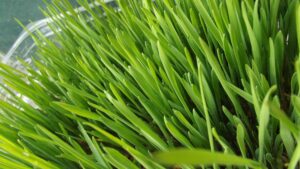Conventional gardening wisdom tells us that you’re best to sow seed just prior to your grass’ peak growing period – early autumn for warm season grasses, and early spring for cool season grasses. But there may be another way.
Grasses, particularly warm season varieties, tend to go dormant over winter. The chill in the air and the attacks from frost cause the blades to brown, and the plant goes into a form of hibernation, waiting to spring back to life when the warmer weather hits. Dormant seeding is the process of sowing seed (usually on top of an already established grass) just prior to or during this dormant period, where it will sit ungerminated over winter, before coming to life in the spring.
When is dormant seeding appropriate?
Quite often dormant seeding is done when it’s the only option. Perhaps scheduling commitments mean that you’ll not get the opportunity to seed in spring. Perhaps you need to overseed a piece of turf that will be occupied in autumn and spring, such as a sports field. Maybe your area experiences particularly wet springs, and seeding in this period could result in seed either being washed away, or being inhibited by waterlogged soil. In this case, dormant seeding over winter will allow the seed to work its way into the soil, anchoring itself and germinating as early as possible.
Where in Australia can I dormant seed?
Dormant seeding in Australia, however, can come with quite a large asterisk. While it’s semi-common in Europe and North America, this can be put down to the fact that their climates are comparatively cold. Some seeds can start to germinate in soils as cold as 10C, temperatures above which are common in the Australian winter.
This being the case, dormant seeding is a more viable option in areas that experience cold Australian winters. Tasmania, Southern Victoria, and areas in the Blue Mountains will more often than not be appropriate. For other temperate areas, a very careful choice of seed is required to ensure the grass doesn’t germinate when growing conditions aren’t ideal. Some seeds, particularly cool season seeds, are more prone to germinate in cold conditions than others.
If you’re unsure whether your preferred seed is suitable for dormant seeding in your area, consult your local McKays team.
Should I dormant seed my lawn myself?
Generally speaking, dormant seeding is best left to the experts. It can be a tricky business, requiring a good amount of training and expertise to get right. Even if you do everything right, you’re still at the mercy of Mother Nature, who can cancel out any good work in quick fashion.
Because dormant seeding is such a tightrope walk, most homeowners will find their seed investment going to waste. For that reason, hiring a professional is recommended.
How do I go about dormant seeding?
Because dormant seeding most often occurs in particularly cold climates, many of the strategies developed for dormant seeding are based around capitalising on the unique conditions offered by such weather.
One successful method is to apply your seed over the top of a frost. By laying the seed atop the frozen dew, it will then be encapsulated by water when the frost finally melts, which will drag the seed down to the base of the lawn, and offer excellent seed-to-soil contact.
If your area is prone to snow, another technique is to apply your seed just prior to a predicted fall. Snow offers excellent protection to dormant seeds, ensuring that they aren’t blown or washed away. The seeds will slowly work their way down to the soil over the course of the winter. You can even apply dormant seeds over the top of snow falls of less than 5cm, as these will act in much the same way as a frost, grabbing the seed and taking it to the base of your lawn as the snow melts.
While dormant seeding can be a complicated business, when done properly, it can be an effective way to rejuvenate your lawn. If you’ve got any further questions regarding dormant seeding, contact the experts at McKays.



